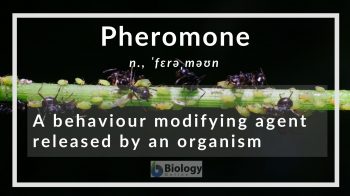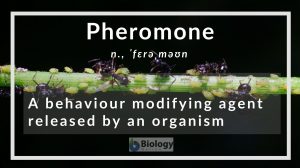
Pheromone
n., ˈfɛrəˌməʊn
A behaviour modifying agent released by an organism. An example is a trail pheromone secreted by ants.
Table of Contents
Pheromone Definition
A pheromone is a chemical released by an organism and serves as a behavior-modifying agent. It means it can change the behavior of members of the same species when the latter detects them.
Overview
The term pheromone came from the Ancient Greek φέρω (phero), meaning “to bear” and ὁρμων (hormon), meaning “stimulating”. Bombykol, a chemical released by the female silkworm for attracting males of the same species, is described to be the first pheromone to be identified in1959. (Ref. 1, 2)
Is pheromone a hormone? A hormone, in the general sense, is a regulatory substance. It incites its target to respond or act. In humans and other animals, hormones are produced and secreted by the endocrine glands. In plants, they are released to regulate various plant activities, e.g. growth and senescence. In some references, pheromones are a hormone, particularly an ectohormone, since it is excreted and it works outside the body of the organism. (Ref. 2)
In mammals, the pheromones are detected through the vomeronasal organ (Jacobson’s organ). This organ is located in the nose and connected to the hypothalamus in the brain. Humans have vomeronasal organs, too, but only at the fetal stage. They atrophy prior to birth. (Ref. 2) Human pheromones are not yet well established. (Ref. 2, 3) If they do occur, humans may be detecting them not by the vomeronasal organs but most likely through their normal olfactory system. (Ref. 2)
Biological Importance
The pheromones secreted or excreted by some organisms can influence the physiology or behavior of their conspecifics (members of the same species). Many of them are used for attracting mates of the opposite sex. They are referred to as sex pheromones. Other pheromones are used to raise an alarm or to signal a food trail. There are also pheromones that are used to delineate territory. (Ref. 2) For example, the pheromones in the dog urine will mark the dog’s territory. Thus, pheromones are a means for organisms to communicate. In fact, most insects use pheromones to communicate with each other. (Ref. 2)
References
- Butenandt, A., Beckmann, R., & Hecker, E. (1961). Über den Sexuallockstoff des Seidenspinners, I. Der biologische Test und die Isolierung des reinen Sexuallockstoffes Bombykol. Hoppe-Seyler´s Zeitschrift Für Physiologische Chemie, 324(Jahresband), 71–83. https://doi.org/10.1515/bchm2.1961.324.1.71
- Brazier, Y. (2018, February 16). What are pheromones and do humans have them? Medicalnewstoday.Com; Medical News Today. https://www.medicalnewstoday.com/articles/232635
- Do human pheromones actually exist. (2017, March 8). Do human pheromones actually exist? Science | AAAS. https://www.sciencemag.org/news/2017/03/do-human-pheromones-actually-exist
©BiologyOnline. Content provided and moderated by BiologyOnline Editors.







